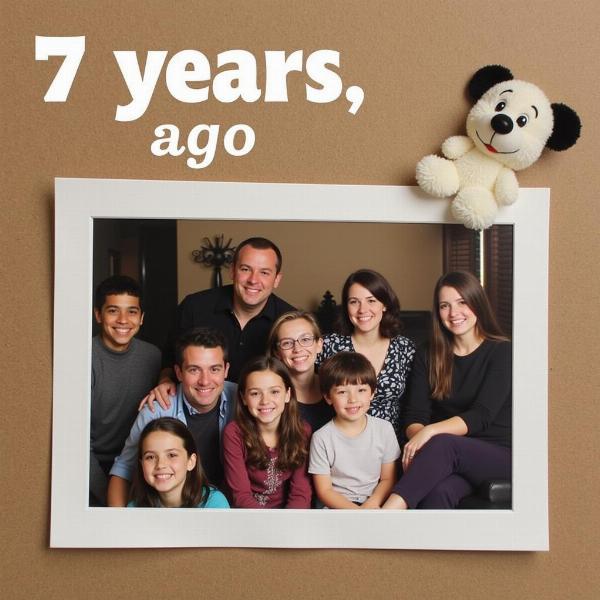Understanding how to express past time in Hindi can be tricky, especially when dealing with specific periods like “7 years ago.” This article will delve into the nuances of expressing “7 years ago” in Hindi, providing various options and exploring the cultural context surrounding time expressions. We’ll also discuss common mistakes to avoid and offer practical examples to help you confidently use this phrase in everyday conversations.
Ways to Say “7 Years Ago” in Hindi
There are several ways to express “7 years ago” in Hindi, each with slightly different connotations and levels of formality. Choosing the right phrase depends on the context of the conversation.
-
Saat Saal Pehle (सात साल पहले): This is the most straightforward and commonly used translation. “Saat” means seven, “saal” means year, and “pehle” means ago or before. It’s suitable for both formal and informal settings.
-
Saat Varsh Pehle (सात वर्ष पहले): “Varsh” is a more formal and literary word for year. Using this phrase adds a touch of sophistication to your language.
-
Saat Saal Purv (सात साल पूर्व): “Purv” is another synonym for “pehle,” often used in more formal or literary contexts. This option is suitable for writing or formal speeches.
-
Saat Saal Pahle Se (सात साल पहले से): Adding “se” (from) at the end emphasizes the starting point of the seven-year period. For instance, “I’ve been living here since seven years ago” would translate to “Main yahan saat saal pahle se rah raha hun” (मैं यहां सात साल पहले से रह रहा हूँ).
Common Mistakes and How to Avoid Them
A common mistake learners make is directly translating English sentence structure into Hindi. This can lead to unnatural phrasing. For example, saying “pehle saat saal” (पहले सात साल) literally translates to “before seven years” but isn’t grammatically correct in Hindi. Always place the time period (saat saal) before the word “pehle,” “purv,” or “pahle se.”
Practical Examples and Usage
Here are some examples of how to use “7 years ago” in different contexts:
-
“I met him 7 years ago.” – “Main unse saat saal pehle mila tha.” (मैं उनसे सात साल पहले मिला था.)
-
“The house was built 7 years ago.” – “Yeh ghar saat saal pehle bana tha.” (यह घर सात साल पहले बना था.)
-
“7 years ago, things were different.” – “Saat saal pehle, baatein alag thi.” (सात साल पहले, बातें अलग थीं.)
 Family photo from 7 years ago
Family photo from 7 years ago
Understanding Time in Hindi Culture
Time perception in India is often viewed cyclically rather than linearly. While specific time expressions exist, there’s also a cultural emphasis on relative time and approximation. In casual conversation, approximations like “kuch saal pehle” (कुछ साल पहले – a few years ago) might be used even when referring to a specific timeframe.
Why Was I Searching for “7 Years Ago Meaning in Hindi”?
You might have searched for this phrase for various reasons:
- Learning Hindi: You’re likely a language learner wanting to expand your vocabulary and understand how to express past time accurately.
- Translation: You may need to translate a document or conversation containing this phrase.
- Genealogy research: Perhaps you’re tracing your family history and encountered a document mentioning a date seven years prior.
- General curiosity: You might simply be curious about how different languages express time.
Conclusion
Expressing “7 years ago” in Hindi involves using variations of “saal” (year) and “pehle” (ago). Selecting the appropriate term depends on the context and desired level of formality. Understanding these nuances will enhance your communication skills and provide a deeper appreciation of Hindi’s rich linguistic tapestry.
FAQ
-
What’s the most common way to say “7 years ago” in Hindi? Saat saal pehle (सात साल पहले) is the most common and straightforward translation.
-
Is there a more formal way to express this? Using varsh (वर्ष) instead of saal (साल), as in saat varsh pehle (सात वर्ष पहले), adds a touch of formality.
-
Can I say “pehle saat saal”? No, this word order is incorrect in Hindi. The time period should always precede “pehle.”
-
What does “purv” mean? “Purv” (पूर्व) is another synonym for “pehle” and is often used in more formal or literary contexts.
-
How does Indian culture perceive time? Time in India is often viewed cyclically, with an emphasis on relative time and approximation.
Related Articles
- meaning of rift in hindi
- while ago meaning in hindi
- year ago meaning in hindi
- 4 years later meaning in hindi
About Meaning-Hindi.in
Meaning-Hindi.in is your trusted partner for high-quality Hindi translation services, specializing in various domains including business, legal, technical, website localization, educational, and specialized content. Our experienced team delivers accurate and culturally sensitive translations, ensuring your message resonates effectively with your target audience. From business documents to legal contracts, we handle projects of all sizes with precision and efficiency. Contact us today to discuss your translation needs: Email: [email protected], Phone: +91 11-4502-7584. Let Meaning-Hindi.in bridge the language gap for you.